Coyote Run
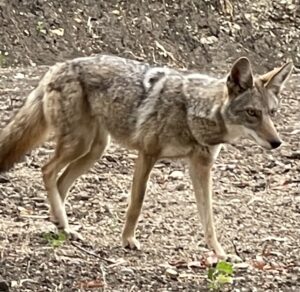 Every morning at dawn I walk down the driveway with my dog, Zoey, to get the newspaper. When we stepped outside one day a couple of years ago, a coyote stood in the front yard. Lean with a dirty gray coat, spindly legs, long snout, and pointy triangular ears, it lowered its head, and stared at us with piercing close-set eyes.
Every morning at dawn I walk down the driveway with my dog, Zoey, to get the newspaper. When we stepped outside one day a couple of years ago, a coyote stood in the front yard. Lean with a dirty gray coat, spindly legs, long snout, and pointy triangular ears, it lowered its head, and stared at us with piercing close-set eyes.
I keep Zoey’s leash in a peach basket just outside the door. She gave out a guttural cry and sprang forward before I had a chance to reach for it.
The coyote ran down my driveway and took off up the street. The hair on Zoey’s back spiking into a mohawk, every muscle in her body bulging, her teeth bared, she gave chase.
 Zoey is an American Bulldog, two feet tall at the shoulders, weighing 70 pounds. The average coyote is her height but less than half her weight. When Zoey was young, she would have been more than a match for any coyote, but she was eleven years old that day with arthritis in her front shoulders and an artificial back knee, so I wasn’t sure she could survive a fight with this one.
Zoey is an American Bulldog, two feet tall at the shoulders, weighing 70 pounds. The average coyote is her height but less than half her weight. When Zoey was young, she would have been more than a match for any coyote, but she was eleven years old that day with arthritis in her front shoulders and an artificial back knee, so I wasn’t sure she could survive a fight with this one.
Zoey paid me no heed when I yelled at her to stop. I ran after her. Seventy-three years old with double knee replacements, I lost ground on her quickly. By the time I got to the bottom of the driveway, she was fifty yards up the street with the coyote another twenty yards ahead of her. I’d almost lost sight of them when Zoey’s adrenaline surge wore off, and she slowed to a stiff-legged trot. The coyote could have pulled away from her easily, but instead it looked back and stopped. This revived Zoey’s flagging energy, and she charged ahead. The coyote waited until Zoey was almost on it, then hopped off the street, and loped up a steep hill.
 Zoey followed in hot pursuit. About half-way up, her arthritis finally got the best of her. She stumbled and fell, then scrambled to her feet, barking hysterically, but she was too weak to climb higher.
Zoey followed in hot pursuit. About half-way up, her arthritis finally got the best of her. She stumbled and fell, then scrambled to her feet, barking hysterically, but she was too weak to climb higher.
I clumped along the street, staggered up the hill, and grabbed her collar. Breathing hard, I looked up at the summit. A second coyote stood beside the one Zoey had chased. Neither seemed tired or the least bit fearful. While I caught my breath, they watched us closely. When I pulled Zoey back down to the street, they trotted over the hill out of sight.
Back inside the house, Zoey collapsed on the rug in my home-office, and I plopped down in my desk chair. As Zoey lay at my feet, panting furiously, spent, and exhausted, a grudging respect for the fleeing coyote came over me. It had set a trap for a dog too big to take down alone. It stopped on the street to lure Zoey to the top of the hill where its partner was waiting. We were lucky Zoey’s arthritis broke her down. If she’d been able to scale that hill, she’d have been an easy kill in a two-on-one fight.
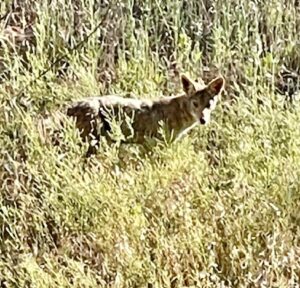 Many of my neighbors’ pets have not been so fortunate.
Many of my neighbors’ pets have not been so fortunate.
My neighborhood is an equestrian community with large lots and miles of trails winding in between and around the properties, all nestled up against a fifty-six-hundred-acre nature preserve. Coyotes migrate from the preserve, set up dens in the brush, and hunt the trails, open fields, and backyards.
Walking my dogs and horseback riding daily, I’ve seen countless coyotes since I moved here, but recently there’s been a change in their behavior. The frequency of sightings has increased. I see coyotes at all times of the day, anywhere and everywhere, in streets, neighbors’ yards, and home construction sites. They shied away from me before. Now, they rarely retreat, even when Zoey and P.D., an 80-pound Pit Bull, are with me. They’re no longer afraid of people.
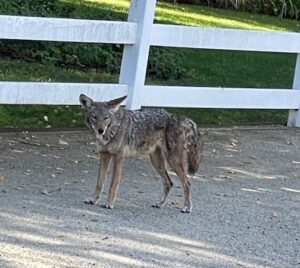 This absence of fear, referred to as habituation, is a dangerous phenomenon. Naturalists Rex Baker and Robert Timm, who studied coyotes in suburban and urban environments, observed seven stages of escalating aggressive behavior among habituated coyotes. Coyotes in my neighborhood have reached stage 5 – attacking pets on a leash or standing near an owner. If Baker and Timm’s study is an accurate predictor of coyote aggression, we need to reverse the progress of habituation before it reaches Stages 6 and 7, threatening actions toward children and adults.
This absence of fear, referred to as habituation, is a dangerous phenomenon. Naturalists Rex Baker and Robert Timm, who studied coyotes in suburban and urban environments, observed seven stages of escalating aggressive behavior among habituated coyotes. Coyotes in my neighborhood have reached stage 5 – attacking pets on a leash or standing near an owner. If Baker and Timm’s study is an accurate predictor of coyote aggression, we need to reverse the progress of habituation before it reaches Stages 6 and 7, threatening actions toward children and adults.
The problem of habituation is not unique to my neighborhood. No one knows how many coyotes there are nationwide, but estimates reach into the millions. In California alone, naturalists think there could be as many as 750,000, and the population is growing. Coyotes are fiercely territorial. As their numbers increase, they spread out to establish new hunting grounds. As a result, they are ubiquitous. They live in virtually every rural, suburban, and urban area from the Arctic Circle to Panama, from New York City to downtown Chicago, San Francisco, and Los Angeles.
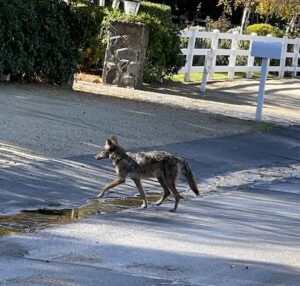 Habituation has reached Stage 5 in countless neighborhoods and reports of attacks on pets are commonplace, but thankfully, attacks on people are rare. Baker and Timm’s study found 367 reported coyote attacks on humans over the four decades from 1977 through 2015. About half occurred in California. Children comprised 40% of the victims, adults 60%. Many of the attacks on small children appeared to be predatory and occurred during the mating and pup-raising season from March through August when coyote mates, who are monogamous for life, are sometimes desperate for prey to feed their young. Attacks on adults often involved people trying to defend their pets from a coyote mauling.
Habituation has reached Stage 5 in countless neighborhoods and reports of attacks on pets are commonplace, but thankfully, attacks on people are rare. Baker and Timm’s study found 367 reported coyote attacks on humans over the four decades from 1977 through 2015. About half occurred in California. Children comprised 40% of the victims, adults 60%. Many of the attacks on small children appeared to be predatory and occurred during the mating and pup-raising season from March through August when coyote mates, who are monogamous for life, are sometimes desperate for prey to feed their young. Attacks on adults often involved people trying to defend their pets from a coyote mauling.
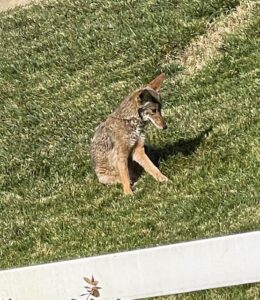 In another study of coyote attacks by Lynsey White and Stanley Gehrt, about half resulted in minor bite wounds. Predatory attacks and rabid coyotes accounted for most of the serious injuries.
In another study of coyote attacks by Lynsey White and Stanley Gehrt, about half resulted in minor bite wounds. Predatory attacks and rabid coyotes accounted for most of the serious injuries.
There have only been two reported fatal coyote attacks in North America. A lone coyote killed a three-year-old girl in front of her house in Glendale, California, in 1985, and a pack of coyotes attacked a young woman on a hiking trail in Canada in 2002.
Coyote studies show that there are no easy ways to reform aggressive behavior once coyotes become habituated. Extermination doesn’t work. About 400,000 coyotes are killed annually, 80,000 by the federal government alone, but coyote populations continue to explode, largely because coyote biology is primed to combat extermination. When the rate of killing increases, females produce larger litters, and newborn coyotes mature faster and quickly fill the habitat vacuum created by the killings.
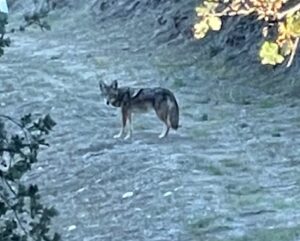 Relocating them is also ineffective. They usually return to their original territory, and when they don’t, other coyotes move in and take over.
Relocating them is also ineffective. They usually return to their original territory, and when they don’t, other coyotes move in and take over.
The most effective alternative to protect pets and people seems to be “hazing,” reviving a coyote’s natural fear of humans. The simplest way to haze is to wave your arms and yell at a coyote, but that alone is often ineffective where habituation has taken hold in the coyote population. Coyote experts recommend blasting airhorns, shaking plastic containers filled with rocks, banging pots and pans together, throwing rocks, turning water hoses on them, and pepper spray.
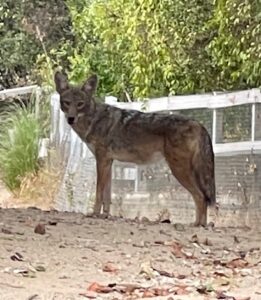 Baker and Timm believe that hazing may not work once a coyote has reached Stage 5, attacking pets in the presence of their owners. They recommend more drastic measures along with hazing to deter aggression at that stage, such as removal of members of the local coyote population through extermination or relocation, to send a message to the remaining pack.
Baker and Timm believe that hazing may not work once a coyote has reached Stage 5, attacking pets in the presence of their owners. They recommend more drastic measures along with hazing to deter aggression at that stage, such as removal of members of the local coyote population through extermination or relocation, to send a message to the remaining pack.
Other studies conclude that hazing can cure a severe coyote habituation problem if all the people in a neighborhood consistently haze every coyote they confront. They recommend community outreach and education to achieve an effective hazing program.
I’m against killing coyotes and in favor of hazing. Coyotes are not evil. They are wild predators, trying to make a living, and important members of the eco system, helping to control the rodent, small mammal, and reptile populations. In my neighborhood’s case, they were here first. We moved into their natural habitat. I feel strongly we should try to coexist with them.
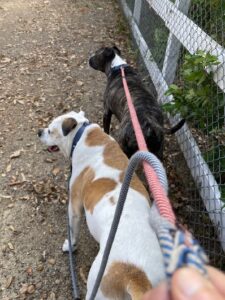 I realize, though, that I might not hold that view if the fleeing coyote’s trap had worked a couple of years ago. If the coyote and its partner had killed Zoey. If I’d heard her death wails. If she’d died in my arms. Some of my neighbors have lost their pets that way. They disagree with me, and I can’t blame them.
I realize, though, that I might not hold that view if the fleeing coyote’s trap had worked a couple of years ago. If the coyote and its partner had killed Zoey. If I’d heard her death wails. If she’d died in my arms. Some of my neighbors have lost their pets that way. They disagree with me, and I can’t blame them.
Meanwhile, I moved that peach basket inside my door. I snap on the leash before we go outside. And I haze every coyote we meet on the trails.
Post Script: All the photographs of coyotes displayed here I took in my neighborhood over the last couple of years before I started hazing them. As you can see, they were almost indifferent to my presence.



September 26, 2022 @ 9:05 pm
Wonderful information and well written! Thank you for stating we need to coexist with them as they were here first. Safety is paramount, as we have 3 small dogs and seven horses. Thank you Ken
September 27, 2022 @ 8:13 am
Thanks, Monika. Coexistence with safety is the goal. It seems achievable. Hazing has been working for me since I realized how and what to do.
September 24, 2022 @ 9:17 am
Really interesting info. I didn’t know about the hazing activity and surely hope it works to keep all safe. I’m thankful so far we don’t have coyotes in my neck of the woods as we do have cats that spend some time outside. But, should any start to appear, I’ll know what to do. Thanks for sharing.
September 24, 2022 @ 11:38 am
From all the articles I read, I’d say they’ll come to your area eventually. It seems there’s no environment they can’t adapt to. I even read a study of coyotes in downtown Chicago. They put a tracking device on a female and found that she established a den on the construction site of a skyscraper. They are amazing creatures.
September 24, 2022 @ 9:03 am
Thanks for the very informative story. As you say, coyotes are pretty much all over the US now but I did not know about them attacking people and pets. I hear they are in the Roanoke-Blacksburg area where we live, but I’ve not seen any personally. I had a tax client who raised alpacas in Greene County. They purchased a llama to protect their herd from coyotes and similar type predators.
September 24, 2022 @ 11:34 am
That’s really interesting. I didn’t know llamas would work against coyotes. Out here I’ve been told donkeys are vigilant defenders against coyotes and other large predators. Back in the 60’s when we hunted in the mountains around Sugar Hollow, there were no coyotes. I’m told now, they’re all through there. The articles I read said the coyote was indigenous to about ten western states until the late 1800’sand early 1900’s, then began to expand. A Nat Geo article said they are as far north as the Arctic circle and all across North America and Central America. They are expected to cross into South America any day now. Naturalists expect them to spread throughout South America within a few decades. They are an amazing success story of adaptation to all environments.
September 23, 2022 @ 8:14 pm
Great information thank you for researching and I agree with you ..
September 24, 2022 @ 11:26 am
Thanks, Janet. Not surprised you agree. Some of my research came from talking to you.
September 23, 2022 @ 5:37 pm
Have you thought of a BB pistol? It would seem to be the most effective hazing, far better than pepper spray of hoses.
September 24, 2022 @ 11:25 am
Yes, I have thought of it and think it’s a good idea. One of my neighbors commented on FB that he uses a pellet gun to defend his back yard. He thinks hazing doesn’t work without a sting.
September 23, 2022 @ 2:56 pm
I live in Amherst’s Virginia now on 93 acres. There are a lot of coyotes here. You can hear them sing at night. I take a weapon with me when walking our Blue Healer dog. She would chase them in a minute. We do allow a couple of hunters to get the aggressive ones that have killed our animals. These coyotes are not nice. Very aggressive Your story reminds me when riding or walking be very aware that they are near. Aldo we have two black bears and three cubs visiting us also. Never a dull moment. But I love the country
September 24, 2022 @ 11:22 am
Great to hear from you, Brenda. I love the Amherst countryside. It’s beautiful. I envy your 93 acres. I agree you have to be ready to defend when you face coyotes. My friend Janet, who made a comment on this blog, and I came up on one riding a trail this morning. He stood and stared at us, unafraid. Janet yelled at him and trotted Jackson toward him, and he finally ran off. Staying armed in the country, especially when your dog is with you, makes sense to me.
September 23, 2022 @ 12:04 pm
Wow! I went along with the chase! I got winded! Just love your exciting story telling. I also like and admire your thinking of living with the wild and your approach for human and animal safety. Your true story reminds me of our Native Americans and the early solutions for them from new folks on their land. Kenny, I pray for your good health and mind so that you can continue to share these wonderful true stories. You hold my attention to the very last word! Many thanks for sharing your incredible talent and time. Your ole’ classmate and friend, Linda
September 23, 2022 @ 12:48 pm
Thank you, Linda! I always look forward to your comments. I’ll try to keep up with you on that good health wish. I saw your FB post of you dancing on your 75th birthday. You haven’t lost a step!
September 23, 2022 @ 11:53 am
Enjoying reading your blog! Always interesting to read about what goes on the other coast sounds like you and your dogs and your grandchildren have to be on alert all the time! Stay safe! Hard to believe how they continue to grow despite all efforts! Amazing!
September 23, 2022 @ 12:45 pm
Coyotes are smart, omnivorous (they eat most everything — fruits, vegetables, garbage, shoe leather, snakes, lizards, insects , and unfortunately dogs and cats), opportunistic, and determined. They are survivors. I find them fascinating, but now that I know the score, I’m keeping my distance and hazing when they come near.
September 23, 2022 @ 10:29 am
Wise advice. A few years ago, at the Main Lodge of the Mammoth Mountain Ski area (east side of the Sierra) a small pack of 4 to 6 coyotes would come up to the edge of the parking lot where humans would feed them. This is the obverse of hazing, and maybe works on the one hand to increase habituaton but, on the other, to deter biting the hand that feeds them.
Just an observation, not a recommendation.
September 23, 2022 @ 12:39 pm
Thanks, Charles. All of the studies I read conclude that feeding coyotes is a big factor in creating habituation, which inevitably leads to conflict. I’m no expert on coyote behavior, but I guess a coyote might think people who feed them won’t object when they pounce on the little dog standing beside them.